Public projects straddle line between art and kitsch
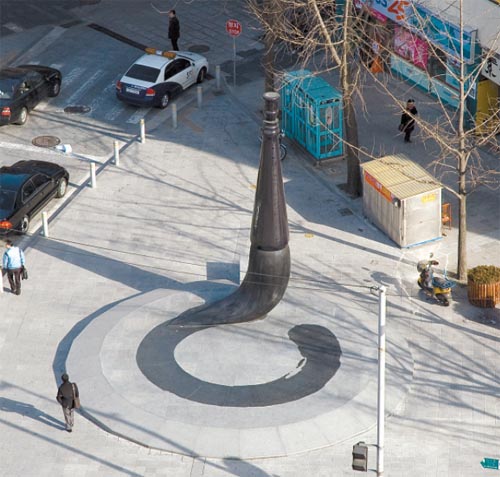
A giant Korean calligraphy brush traces a circle near the Insa-dong shopping street in downtown Seoul, part of the municipal government’s Seoul City Gallery Project.[JoongAng Ilbo]
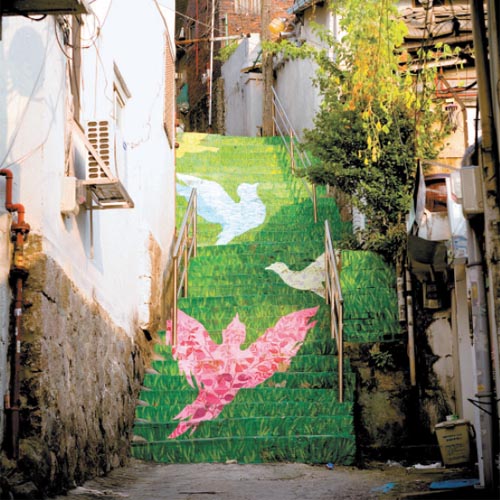
Part of the Culture Ministry’s “Art in City” project in 2006, this fresco painting decorates a stairway leading up to houses in an old village near Naksan Park.
When the Eiffel Tower, designed by Gustave Eiffel to commemorate the 100th anniversary of the French Revolution, first appeared on the Paris skyline in 1889, it was far from welcome. Many locals denounced the structure for as ugly, including the novelist Guy de Maupassant, who detested the structure and allegedly ate regular meals at a restaurant inside it because it was the only place from which the tower was not visible. Today the tower has become a symbol of France itself.
Many pieces of public art are controversial at first.
The giant shell-shaped “Spring” was met with criticism when it was erected in Cheonggye Plaza in 2006. Though the artist, the late Coosje van Bruggen, was already well-known for the public art she had worked on with her husband Claes Oldenburg, the unveiling of her work to commemorate the restoration of Cheonggye Stream at the heart of Seoul did not go as smoothly as expected. Many weren’t satisfied with the colorful seashell.
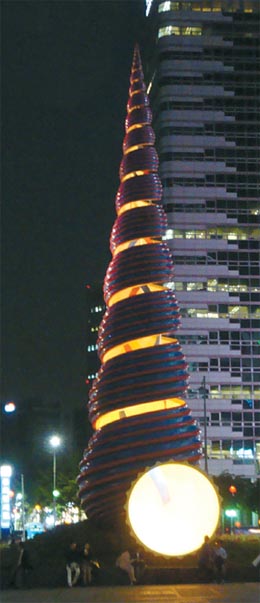
“Spring” by Coosje van Bruggen and Claes Oldenburg stands at the beginning of Cheonggye Stream in downtown Seoul. It provoked controversy on its unveiling in 2006. By Park Sun-young
In early 2005, when the city government selected Bruggen and Oldenburg to produce the piece, Nate, a major Korean Web portal, conducted a survey of 2,200 citizens about the decision. About 95 percent of respondents said they were against the plan, saying that it was absurd to pay 3.4 billion won ($2.8 million) for a foreign art piece at Cheonggye Stream. The main reason for the outrage was that most thought a Korean artist should have been selected instead. Some experts elaborated on those concerns.
Representatives of the local art world including Hwang Byung-ki, professor emeritus at Ewha Womans University, and the architect Kim Won argued that the pop artists’ sensibilities wouldn’t match the Cheonggye Stream, a place where they argued modern and traditional Korean values should coexist. They advocated for a piece by Paik Nam-june, the late Korean-American video artist, instead.
“Considering that Paik grew up in an area near Cheonggye Stream in his childhood, it would be a lot more meaningful if Paik’s piece became the one commemorating the restoration of Cheonggye Stream,” the architect Kim said in an interview with a local newspaper at the time.
But the plan to create Spring went through anyway, and now it stands at the source of the waterway, seen by the millions of people who visit the site each year.
“I think that Spring doesn’t harmonize with the Cheonggye Stream at all. I heard that Oldenburg didn’t even pay a visit to the area before designing the sculpture, which is absurd,” said Hong Kyoung-han, chief editor of Public Art, the local monthly art magazine focusing on public art issues.”
(Many locals mistakenly believe Oldenburg to be the main artist behind the piece.)
“The government seemed to care only about the artist’s reputation without considering whether his artwork would match the place where it will be located. I don’t think that Oldenburg, who is a pop artist well known for his pieces representing commercial capitalism, is the right person for the job,” he said. “Furthermore, it cost more than 3 billion won, which comes from taxes paid by citizens after all, but the citizens’ opinions were hardly reflected in the procedures.”
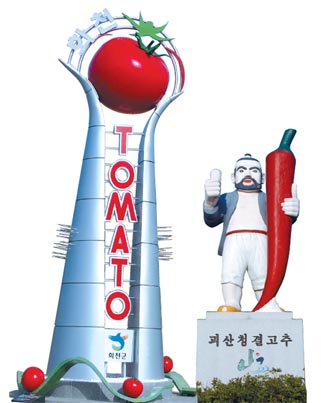
Left: A helpfully labeled tomato stands in Hwacheon, Gangwon. Right: A statue of the folk hero Im Keok-jeong holding a red pepper gives motorists a thumbs up in Goesan, North Chung-cheong. Provided by the local governments
“First, it failed to get public approval as citizens were largely excluded from the process of deciding whether Spring was right for the Cheonggye Stream even though it was a public arts project, and it also failed to reflect the historical and symbolic meaning of the Cheonggye Stream,” Yun said. “Therefore, Spring cannot be free from criticism, but I personally have a positive view of the situation itself since it has provided us with an opportunity to discuss and develop public art.”
Spring, with its excellent pedigree and small group of defenders, might one day gain acceptance like the Eiffel Tower before it. But not all public art is destined for re-evaluation - some really is just bad.
Local governments in recent years have increasingly sponsored public art to represent their areas’ unique characteristics, be it specialty cuisine, festivals or other traditions. Many can only be described as laughable, finding artistic value only in the cultural ghetto of kitsch.
One statue depicts a man with his shirt open, holding a large red pepper close. The man is meant to be Im Keok-jeong, a sort of Korean Robin Hood, and it was erected in 2005 in Goesan, North Chungcheong, to promote the annual Red Pepper Festival, now in its 10th year. It was also considered appropriate because Goesan is the home of Hong Myung-hee, who wrote an epic novel about the honorable thief.
“Red peppers usually evoke an image of hotness and strength, which Im Keok-jeong also relates to,” said a government official at the Goesan County Office who asked not to be named. “I think our piece distinguishes itself from those in other regions, which often lack personality.”
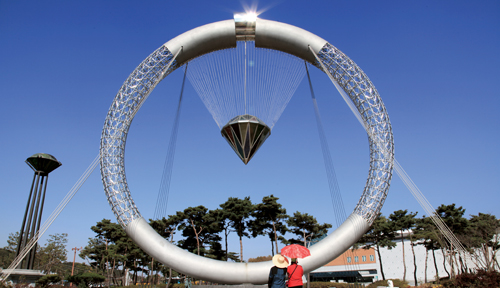
An installation depicting a large ring set with a jewel is located in the Iksan Jewelry Museum, North Jeolla. The city of Iksan specializes in the jewelry processing industry and hosts various jewelry-related events, including the Iksan Jewelry Expo. Provided by the government
“To me, he looks like just a dirty old man, not our Robin Hood Im Keok-jeong,” said Yun at The Ton.
What about the sculpture of an enormous tomato in Hwacheon, Gangwon? Hwacheon has hosted an annual Tomato Festival since 2003, and the regional government came up with the piece last year to promote the event. What pushes the piece from cute camp to ugly kitsch is surely the large English letters that appear in a vertical line below the vegetable itself, spelling “TOMATO.”
“Honestly, I don’t want to see anything like [these pieces] anymore in the future. They’re far below the level where they could be considered works of art,” Yun scoffed. “However, you can still find many of them around the country, which can be attributed to local governments’ excessive desire to promote themselves combined with their lack of ability to carry out such public arts project without consulting professional artists.”
One government official at the Hwacheon County Office confirmed Yun’s claims.
“The piece was produced by a design firm based in Chuncheon, a big city near Hwacheon, because there were not many designers we could turn to in Hwacheon, which is a small town,” said the official, who wished to remain anonymous.
Why didn’t they look to a more qualified designer, say, someone in Seoul?
“There are some issues, such as that a regional government project should contribute to the regional economy, so it is not easy for us to turn our backs on companies in or near the region,” she replied.
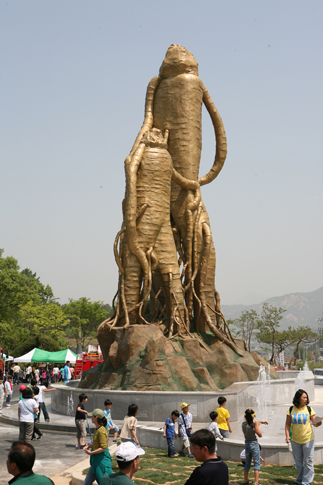
The sculpture of a pair of ginseng was designed to represent the county of Geumsan, South Chungcheong, whose specialty is ginseng. Provided by the government
“Art in City,” a public art project carried out by the Culture Ministry in 2006 and 2007, aimed at improving the living environment for residents in neglected areas. In Naksan, the project hoped to help alleviate the disparity between the relatively well-off Daehangno and the poor hillside village opposite it. As a result of the project, the neighborhood of Ihwa-dong and Naksan Park were adorned with about 60 works of art, including murals and various installations.
The Seoul City Gallery Project since 2007 has worked to turn the capital itself into a work of art - a task considered increasingly important considering Seoul is the World Design Capital in 2010. A large bronze sculpture of a traditional Korean writing brush located at the entrance to Insa-dong is one of more than 300 works aimed at beautifying the cityscape.
Many of the works are tasteful and attractive, but Hong at Public Art is still skeptical.
“The biggest problem with public art-related projects led by the government is that it attaches more importance to the outcome than to the procedures, resulting in an increase in only the number of public art pieces around the country, but not in the quality,” he said. “Moreover, when the time is up for government officials who are in charge of the project, it is often the case that the products [of the project] are just left uncared for.”
Hong argued that public art should be part of citizens’ lives, and that efforts had to be made to reflect their opinions in planning and installing pieces.
“In Japan, for instance, when a public art program takes place in either a big city or a small town, the authorities make sure that they collect opinions from the residents, who will be the ‘actual users’ of the art, through channels such as neighborhood meetings or public hearings,” said Hong.
That is what happened in the small Japanese town of Echigo-Tsumari, which was an economically depressed area until the Echigo-Tsumari Art Triennial turned it into a major tourist attraction.
“We spent enough time talking with villagers about our project and carried it out with their active participation,” said Kitagawa Fram, the general art director of the project, when he was visiting Seoul last month for a public art conference.
“Even now the villagers volunteer to act as guides for sightseers touring the village not only because they directly participated in the project and thus were well aware of it, but also they have a good opinion of the project, which has contributed to reviving the village both economically and culturally,” he said. “The participation of residents in the region was a decisive factor in the success of the project.”
However, it can be tricky to decide to what extent the opinions of the residents or the general public should be reflected in art. Is public art necessarily a public good? What about works that, like the Eiffel Tower, take a while to appreciate?
“I think a public art piece needs to be advanced to some degree, while taking the tastes and opinions of citizens into consideration,” Yun said. “Sometimes, even a fine art piece is not easy on the eyes at first.
“What is important is that citizens should not be left out of the process, because public art is established for the public, after all,” explained Hong. “I think that education for the public on public art is necessary. Public art is a way of communicating with the public itself, and it takes some time, which is in fact natural.”
By Park Sun-young [spark0320@joongang.co.kr]










with the Korea JoongAng Daily
To write comments, please log in to one of the accounts.
Standards Board Policy (0/250자)